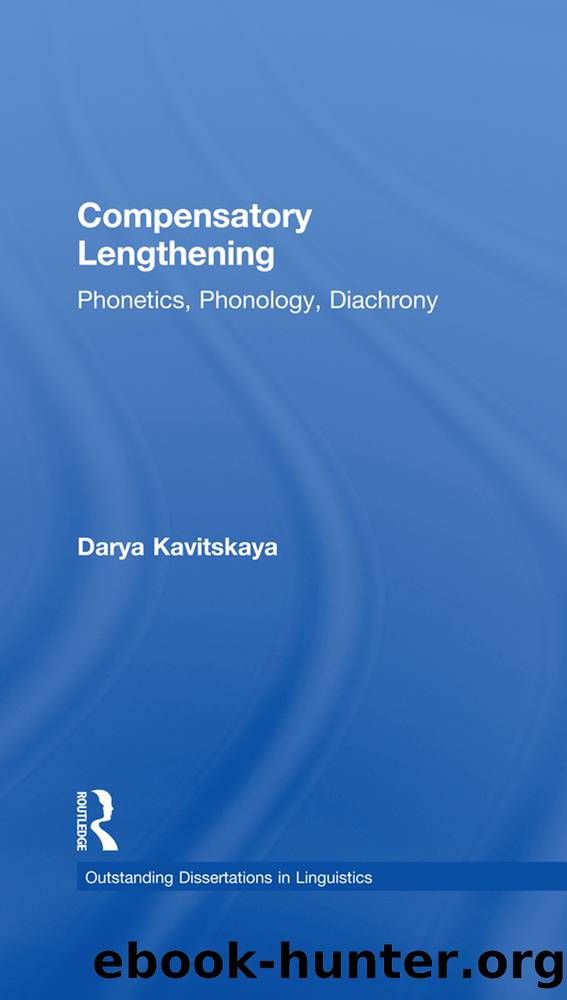Compensatory Lengthening by Kavitskaya Darya;Horn Laurence;

Author:Kavitskaya, Darya;Horn, Laurence; [Kavitskaya, Darya]
Language: eng
Format: epub
Publisher: Taylor & Francis Group
Published: 2022-08-15T00:00:00+00:00
1 Contra Minkova (1982), Lass (1985), Hayes (1989), and Kim (1993), it is suggested by Hoek (1986) and de Chene & Anderson (1979) and convincingly argued by Lahiri & Dresher (1999) that the vowels in stressed syllables in Middle English were not lengthened as a result of CL caused by the loss of final schwa, but rather underwent a process of open syllable lengthening. 2 CVCV CV:C alternations are present in the synchronie grammars of Trukese, and other Austronesian languages, but the historical source for the alternations in question is a bimoraic minimal size condition, which will be discussed in section 4.5. (1â4) are representative examples of CVCV CL from Friulian (Romance), Serbo-Croatian (Slavic), Hungarian (Finno-Ugric), and Lama (Gur) respectively.
In Friulian (1), all unstressed vowels except the low vowel a were lost word-finally, giving rise to the lengthening of preceding accented vowels. (1a) illustrates the correlation of vowel loss with vowel lengthening, (1b) shows an example of a non-deleting final a, and (1c) demonstrates that there is no lengthening of unstressed vowels with the loss of final vowels, that is, after the loss of o in *úmido, i in [úmit] remains short.
Friulian (Hualde 1990)
Download
This site does not store any files on its server. We only index and link to content provided by other sites. Please contact the content providers to delete copyright contents if any and email us, we'll remove relevant links or contents immediately.
Cecilia; Or, Memoirs of an Heiress — Volume 1 by Fanny Burney(32047)
Cecilia; Or, Memoirs of an Heiress — Volume 3 by Fanny Burney(31449)
Cecilia; Or, Memoirs of an Heiress — Volume 2 by Fanny Burney(31401)
The Lost Art of Listening by Michael P. Nichols(7154)
We Need to Talk by Celeste Headlee(5410)
Asking the Right Questions: A Guide to Critical Thinking by M. Neil Browne & Stuart M. Keeley(5352)
On Writing A Memoir of the Craft by Stephen King(4658)
Dialogue by Robert McKee(4156)
Pre-Suasion: A Revolutionary Way to Influence and Persuade by Robert Cialdini(3970)
I Have Something to Say: Mastering the Art of Public Speaking in an Age of Disconnection by John Bowe(3774)
Elements of Style 2017 by Richard De A'Morelli(3234)
The Book of Human Emotions by Tiffany Watt Smith(3137)
Fluent Forever: How to Learn Any Language Fast and Never Forget It by Gabriel Wyner(2915)
Name Book, The: Over 10,000 Names--Their Meanings, Origins, and Spiritual Significance by Astoria Dorothy(2835)
Good Humor, Bad Taste: A Sociology of the Joke by Kuipers Giselinde(2821)
Why I Write by George Orwell(2771)
The Grammaring Guide to English Grammar with Exercises by Péter Simon(2646)
The Art Of Deception by Kevin Mitnick(2621)
Don't Sleep, There Are Snakes by Daniel L. Everett(2496)
